A Comprehensive Review on Printed Electronics: A Technology Drift towards a Sustainable Future
Abstract
1. Introduction
2. Materials and Process: Assessment
2.1. Metallic Nanoparticle Ink
2.2. Metal Oxide Nanoparticle Ink
2.3. 2D-Material Ink
2.4. Molecular Ink
2.5. UV-Curable Ink
3. Printing Technologies
3.1. Inkjet Printing
3.2. Aerosol Jet Printing
3.3. Extrusion-Based Printing
3.4. Electrohydrodynamic Printing
3.5. Light-Based Printing
4. Printing Quality
5. Coffee Ring Effect
6. Applications of 3D-Printing Technology
7. Conclusions
- Systematic assessment in the past 10 years based on emergent printed electronics from the perspective of materials and various processing techniques. In addition, various ink materials with superior electrical and mechanical properties to ensure their pathways in the electronics industry are discussed.
- The prominent role of printing ink and its classification based on the ink materials are also discussed. We conducted a comprehensive review of metal oxide nanoparticle ink, metal nanoparticle ink, 2D material ink, molecular ink, and UV-curable ink. Among them, metal nanoparticle inks are highly desirable for high-conducting metal lines and electrodes. Conversely, metal oxide nanoparticle ink can exhibit conducting and dielectric nature. Molecular and UV-curable ink has a flexible nature which makes it highly suitable for flexible electronics applications.
- A critical assessment on the potential of diverse printing technology and its ability in contributing to the semiconductor industry for sustainable manufacturing are presented. In addition, we discussed the role of printed metal lines and electrodes by inkjet, aerosol, and electrohydrodynamic printing for the state-of the art semiconductor process and interconnects. We discussed the correlation of the surface tension of the printing ink for nanometer-scaled resolution using electrohydrodynamic printing.
- The printing quality of the metal line and their classification such as fine lines, uneven edges, and overflow are also holistically discussed. Also, the prominent role of the coffee ring effect in inkjet and aerosol jet printing technology and also various methods proposed to mitigate the effect are envisaged.
- The present work will be helpful in providing insight into this emerging technology to the spectrum of researchers and industrial professionals. The highly stable and reliable features of printed conductive inks imply a promising future in flexible electronics and their applications. We also discussed the various applications of printed electronics in electronic devices, energy devices, sensors, and biomedical devices which have promising applications.
Author Contributions
Funding
Acknowledgments
Conflicts of Interest
Abbreviations
| AM | Additive Manufacturing |
| 3D | 3-Dimensional |
| 2D | 2-Dimensional |
| PET | Polyethylene Terephthalate |
| ITO | Indium Tin Oxide |
| h-BN | Hexagonal Boron Nitride |
| PEDOT: PSS | Poly(3,4-ethylene dioxythiophene) Polystyrene Sulfonate |
| FE-SEM | Field Emission Scanning Electron Microscopes |
| SEM | Scanning Electron Microscopes |
| IZO | Indium-Doped Zinc Oxide |
| MOD | Metal-Organic Decomposition |
| UV | Ultraviolet |
| RFID | Radio Frequency Identification |
| FET | Field Effect Transistor |
| EMG | Electromyography |
| FDM | Fused Deposition Modeling |
| DC | Direct Current |
| EDX | Energy Dispersive X-Ray |
| EG | Ethylene Glycol |
| DMSO | Dimethyl sulfoxide |
| DMF | Dimethylformamide |
| IPA | Isopropyl Alcohol |
| S-PDMS | Lubricant-infused Polydimethylsiloxane |
| NIR | Near-Infrared |
| GO | Graphene Oxide |
| SWCNT | Single-Wall Carbon Nanotube |
References
- WSTS Semiconductor Market Forecast Spring 2022. WSTS News Releases. 2022. Available online: https://www.wsts.org/ (accessed on 22 August 2022).
- Shen, C.; Tran, P.; Minh Ly, P. Chemical Waste Management in the U.S. Semiconductor Industry. Sustainability 2018, 10, 1545. [Google Scholar] [CrossRef]
- Cai, F.; Chang, Y.-H.; Wang, K.; Zhang, C.; Wang, B.; Papapolymerou, J. Low-Loss 3-D Multilayer Transmission Lines and Interconnects Fabricated by Additive Manufacturing Technologies. IEEE Trans. Microw. Theory Tech. 2016, 64, 3208–3216. [Google Scholar] [CrossRef]
- Song, O.; Rhee, D.; Kim, J.; Jeon, Y.; Mazánek, V.; Söll, A.; Kwon, Y.A.; Cho, J.H.; Kim, Y.-H.; Sofer, Z.; et al. All Inkjet-Printed Electronics Based on Electrochemically Exfoliated Two-Dimensional Metal, Semiconductor, and Dielectric. npj 2D Mater. Appl. 2022, 6, 64. [Google Scholar] [CrossRef]
- Salea, A.; Prathumwan, R.; Junpha, J.; Subannajui, K. Metal Oxide Semiconductor 3D Printing: Preparation of Copper(ii) Oxide by Fused Deposition Modelling for Multi-Functional Semiconducting Applications. J. Mater. Chem. C 2017, 5, 4614–4620. [Google Scholar] [CrossRef]
- Hofer, A.-K.; Kocjan, A.; Bermejo, R. High-Strength Lithography-Based Additive Manufacturing of Ceramic Components with Rapid Sintering. Addit. Manuf. 2022, 59, 103141. [Google Scholar] [CrossRef]
- Ligon, S.C.; Liska, R.; Stampfl, J.; Gurr, M.; Mülhaupt, R. Polymers for 3D Printing and Customized Additive Manufacturing. Chem. Rev. 2017, 117, 10212–10290. [Google Scholar] [CrossRef]
- Tiedje, T.; Lungen, S.; Schubert, M.; Luniak, M.; Nieweglowski, K.; Bock, K. Will Low-Cost 3D Additive Manufactured Packaging Replace the Fan-Out Wafer Level Packages? In Proceedings of the 2017 IEEE 67th Electronic Components and Technology Conference (ECTC), Orlando, FL, USA, 30 May–2 June 2017; pp. 1065–1070. [Google Scholar]
- Votzke, C.; Daalkhaijav, U.; Menguc, Y.; Johnston, M.L. 3D-Printed Liquid Metal Interconnects for Stretchable Electronics. IEEE Sens. J. 2019, 19, 3832–3840. [Google Scholar] [CrossRef]
- Shijian, L.; Harris, T.; Wong, C.P. Study on Surface Tension and Adhesion for Flip Chip Packaging. In Proceedings of the International Symposium on Advanced Packaging Materials Processes, Properties and Interfaces (IEEE Cat. No.01TH8562), Braselton, GA, USA, 11–14 March 2001; pp. 299–304. [Google Scholar]
- Lindner, M.; Rodler, N.; Jesdinszki, M.; Schmid, M.; Sängerlaub, S. Surface Energy of Corona Treated PP, PE and PET Films, Its Alteration as Function of Storage Time and the Effect of Various Corona Dosages on Their Bond Strength after Lamination. J. Appl. Polym. Sci. 2018, 135, 45842. [Google Scholar] [CrossRef]
- Hu, G.; Albrow-Owen, T.; Jin, X.; Ali, A.; Hu, Y.; Howe, R.C.T.; Shehzad, K.; Yang, Z.; Zhu, X.; Woodward, R.I.; et al. Black Phosphorus Ink Formulation for Inkjet Printing of Optoelectronics and Photonics. Nat. Commun. 2017, 8, 278. [Google Scholar] [CrossRef] [PubMed]
- Wiklund, J.; Karakoç, A.; Palko, T.; Yiğitler, H.; Ruttik, K.; Jäntti, R.; Paltakari, J. A Review on Printed Electronics: Fabrication Methods, Inks, Substrates, Applications and Environmental Impacts. J. Manuf. Mater. Process. 2021, 5, 89. [Google Scholar] [CrossRef]
- Dimitriou, E.; Michailidis, N. Printable Conductive Inks Used for the Fabrication of Electronics: An Overview. Nanotechnology 2021, 32, 502009. [Google Scholar] [CrossRef]
- Matsui, H.; Takeda, Y.; Tokito, S. Flexible and Printed Organic Transistors: From Materials to Integrated Circuits. Org. Electron. 2019, 75, 105432. [Google Scholar] [CrossRef]
- Baldini, G.; Albini, A.; Maiolino, P.; Cannata, G. An Atlas for the Inkjet Printing of Large-Area Tactile Sensors. Sensors 2022, 22, 2332. [Google Scholar] [CrossRef] [PubMed]
- Grubb, P.M.; Subbaraman, H.; Park, S.; Akinwande, D.; Chen, R.T. Inkjet Printing of High Performance Transistors with Micron Order Chemically Set Gaps. Sci. Rep. 2017, 7, 1202. [Google Scholar] [CrossRef]
- Wang, X.; Lu, Q.; Chen, C.; Han, M.; Wang, Q.; Li, H.; Niu, Z.; Chen, J. A Consecutive Spray Printing Strategy to Construct and Integrate Diverse Supercapacitors on Various Substrates. ACS Appl. Mater. Interfaces 2017, 9, 28612–28619. [Google Scholar] [CrossRef]
- Tan, H.W.; An, J.; Chua, C.K.; Tran, T. Metallic Nanoparticle Inks for 3D Printing of Electronics. Adv. Electron. Mater. 2019, 5, 1800831. [Google Scholar] [CrossRef]
- Mekhmouken, S.; Battaglini, N.; Mattana, G.; Maurin, A.; Zrig, S.; Piro, B.; Capitao, D.; Noel, V. Gold Nanoparticle-Based Eco-Friendly Ink for Electrode Patterning on Flexible Substrates. Electrochem. Commun. 2021, 123, 106918. [Google Scholar] [CrossRef]
- Fernandes, I.J.; Aroche, A.F.; Schuck, A.; Lamberty, P.; Peter, C.R.; Hasenkamp, W.; Rocha, T.L.A.C. Silver Nanoparticle Conductive Inks: Synthesis, Characterization, and Fabrication of Inkjet-Printed Flexible Electrodes. Sci. Rep. 2020, 10, 8878. [Google Scholar] [CrossRef]
- Niittynen, J.; Sowade, E.; Kang, H.; Baumann, R.R.; Mäntysalo, M. Comparison of Laser and Intense Pulsed Light Sintering (IPL) for Inkjet-Printed Copper Nanoparticle Layers. Sci. Rep. 2015, 5, 8832. [Google Scholar] [CrossRef]
- Lee, Y.J.; Lee, C.; Lee, H.M. Synthesis of Oxide-Free Aluminum Nanoparticles for Application to Conductive Film. Nanotechnology 2018, 29, 055602. [Google Scholar] [CrossRef]
- Nelo, M.; Myllymäki, S.; Juuti, J.; Uusimäki, A.; Jantunen, H. Cobalt Nanoparticle Inks for Printed High Frequency Applications on Polycarbonate. J. Electron. Mater. 2015, 44, 4884–4890. [Google Scholar] [CrossRef]
- Park, S.-H.; Kim, H.-S. Flash Light Sintering of Nickel Nanoparticles for Printed Electronics. Thin Solid Films 2014, 550, 575–581. [Google Scholar] [CrossRef]
- Arsenov, P.V.; Efimov, A.A.; Ivanov, V.V. Optimizing Aerosol Jet Printing Process of Platinum Ink for High-Resolution Conductive Microstructures on Ceramic and Polymer Substrates. Polymers 2021, 13, 918. [Google Scholar] [CrossRef]
- Majee, S.; Karlsson, M.C.F.; Wojcik, P.J.; Sawatdee, A.; Mulla, M.Y.; ul Hassan Alvi, N.; Dyreklev, P.; Beni, V.; Nilsson, D. Low Temperature Chemical Sintering of Inkjet-Printed Zn Nanoparticles for Highly Conductive Flexible Electronic Components. npj Flex. Electron. 2021, 5, 14. [Google Scholar] [CrossRef]
- Tseng, C.-C.; Chang, C.-P.; Sung, Y.; Chen, Y.-C.; Ger, M.-D. A Novel Method to Produce Pd Nanoparticle Ink for Ink-Jet Printing Technology. Colloids Surfaces A Physicochem. Eng. Asp. 2009, 339, 206–210. [Google Scholar] [CrossRef]
- Jo, Y.H.; Jung, I.; Choi, C.S.; Kim, I.; Lee, H.M. Synthesis and Characterization of Low Temperature Sn Nanoparticles for the Fabrication of Highly Conductive Ink. Nanotechnology 2011, 22, 225701. [Google Scholar] [CrossRef]
- Albrecht, A.; Rivadeneyra, A.; Abdellah, A.; Lugli, P.; Salmerón, J.F. Inkjet Printing and Photonic Sintering of Silver and Copper Oxide Nanoparticles for Ultra-Low-Cost Conductive Patterns. J. Mater. Chem. C 2016, 4, 3546–3554. [Google Scholar] [CrossRef]
- Mazzotta, A.; Gabbani, A.; Carlotti, M.; Ruggeri, M.; Fantechi, E.; Ottomaniello, A.; Pineider, F.; Pucci, A.; Mattoli, V. Invisible Thermoplasmonic Indium Tin Oxide Nanoparticle Ink for Anti-Counterfeiting Applications. ACS Appl. Mater. Interfaces 2022. [Google Scholar] [CrossRef] [PubMed]
- Cho, S.Y.; Kang, Y.H.; Jung, J.-Y.; Nam, S.Y.; Lim, J.; Yoon, S.C.; Choi, D.H.; Lee, C. Novel Zinc Oxide Inks with Zinc Oxide Nanoparticles for Low-Temperature, Solution-Processed Thin-Film Transistors. Chem. Mater. 2012, 24, 3517–3524. [Google Scholar] [CrossRef]
- Wang, W.; Li, Q.; Zheng, A.; Li, X.; Pan, Z.; Jiang, J.; Zhang, L.; Hong, R.; Zhuang, L. Superparamagnetic Iron Oxide Nanoparticles for Full-Color Photonic Materials with Tunable Properties. Results Phys. 2019, 14, 102366. [Google Scholar] [CrossRef]
- Kela, L.; Auvinen, A.; Tapper, U.; Hokkinen, J. Metallic Nanoparticles for Conductive Inks. In Proceedings of the International Congress of Metallurgy and Materials, SAM- CONAMET/IBEROMAT, Santa Fe, Argentina, 21–24 October 2014; pp. 1–3. [Google Scholar]
- Choi, Y.-H.; Kim, D.-H.; Han, H.S.; Shin, S.; Hong, S.-H.; Hong, K.S. Direct Printing Synthesis of Self-Organized Copper Oxide Hollow Spheres on a Substrate Using Copper(II) Complex Ink: Gas Sensing and Photoelectrochemical Properties. Langmuir 2014, 30, 700–709. [Google Scholar] [CrossRef]
- Ito, D.; Masuko, K.; Weintraub, B.A.; McKenzie, L.C.; Hutchison, J.E. Convenient Preparation of ITO Nanoparticles Inks for Transparent Conductive Thin Films. J. Nanoparticle Res. 2012, 14, 1–7. [Google Scholar] [CrossRef]
- Suganthi, K.S.; Harish, K.; Nair, N.M.; Swaminathan, P. Formulation and Optimization of a Zinc Oxide Nanoparticle Ink for Printed Electronics Applications. Flex. Print. Electron. 2018, 3, 015001. [Google Scholar] [CrossRef]
- Arrabito, G.; Aleeva, Y.; Pezzilli, R.; Ferrara, V.; Medaglia, P.G.; Pignataro, B.; Prestopino, G. Printing ZnO Inks: From Principles to Devices. Crystals 2020, 10, 449. [Google Scholar] [CrossRef]
- Kim, H.J.; Jung, J.; Kim, H.J. Enhancement of Electrical Characteristics and Stability of Self-Patterned In–Zn–O Thin-Film Transistors Based on Photosensitive Precursors. Sci. Rep. 2020, 10, 18853. [Google Scholar] [CrossRef]
- Vaseem, M.; Ghaffar, F.A.; Farooqui, M.F.; Shamim, A. Iron Oxide Nanoparticle-Based Magnetic Ink Development for Fully Printed Tunable Radio-Frequency Devices. Adv. Mater. Technol. 2018, 3, 1700242. [Google Scholar] [CrossRef]
- Lathiya, P.; Wang, J. Magnetite Nanoparticles (Fe 3 O 4) for Radio-Frequency and Microwave Applications. In Iron Oxide Nanoparticles [Working Title]; IntechOpen: Rijeka, Croatia, 2022. [Google Scholar]
- Franco, M.; Alves, R.; Perinka, N.; Tubio, C.; Costa, P.; Lanceros-Mendéz, S. Water-Based Graphene Inks for All-Printed Temperature and Deformation Sensors. ACS Appl. Electron. Mater. 2020, 2, 2857–2867. [Google Scholar] [CrossRef]
- Pereira, N.M.; Rezende, N.P.; Cunha, T.H.R.; Barboza, A.P.M.; Silva, G.G.; Lippross, D.; Neves, B.R.A.; Chacham, H.; Ferlauto, A.S.; Lacerda, R.G. Aerosol-Printed MoS 2 Ink as a High Sensitivity Humidity Sensor. ACS Omega 2022, 7, 9388–9396. [Google Scholar] [CrossRef] [PubMed]
- Leng, T.; Parvez, K.; Pan, K.; Ali, J.; McManus, D.; Novoselov, K.S.; Casiraghi, C.; Hu, Z. Printed Graphene/WS 2 Battery-Free Wireless Photosensor on Papers. 2D Mater. 2020, 7, 024004. [Google Scholar] [CrossRef]
- Khan, M.U.; Awais, M.; Chattha, T.E.; Hassan, A.; Bae, J. All Printed Wide Range Humidity Sensor Array Combining MoSe2 and PVOH in Series. J. Mater. Sci. Mater. Electron. 2020, 31, 7683–7697. [Google Scholar] [CrossRef]
- Zhu, X.; Ng, L.W.T.; Hu, G.; Wu, T.; Um, D.; Macadam, N.; Hasan, T. Hexagonal Boron Nitride–Enhanced Optically Transparent Polymer Dielectric Inks for Printable Electronics. Adv. Funct. Mater. 2020, 30, 2002339. [Google Scholar] [CrossRef] [PubMed]
- Jang, S.K.; Youn, J.; Song, Y.J.; Lee, S. Synthesis and Characterization of Hexagonal Boron Nitride as a Gate Dielectric. Sci. Rep. 2016, 6, 30449. [Google Scholar] [CrossRef] [PubMed]
- Torrisi, F.; Hasan, T.; Wu, W.; Sun, Z.; Lombardo, A.; Kulmala, T.S.; Hsieh, G.-W.; Jung, S.; Bonaccorso, F.; Paul, P.J.; et al. Inkjet-Printed Graphene Electronics. ACS Nano 2012, 6, 2992–3006. [Google Scholar] [CrossRef] [PubMed]
- Paterson, T.E.; Hagis, N.; Boufidis, D.; Wang, Q.; Moore, S.R.; da Silva, A.C.; Mitchell, R.L.; Alix, J.J.P.; Minev, I.R. Monitoring of Hand Function Enabled by Low Complexity Sensors Printed on Textile. Flex. Print. Electron. 2022, 7, 035003. [Google Scholar] [CrossRef]
- Lopez-Sanchez, O.; Lembke, D.; Kayci, M.; Radenovic, A.; Kis, A. Ultrasensitive Photodetectors Based on Monolayer MoS2. Nat. Nanotechnol. 2013, 8, 497–501. [Google Scholar] [CrossRef]
- Liu, X.; Hu, S.; Lin, Z.; Li, X.; Song, L.; Yu, W.; Wang, Q.; He, W. High-Performance MoS 2 Photodetectors Prepared Using a Patterned Gallium Nitride Substrate. ACS Appl. Mater. Interfaces 2021, 13, 15820–15826. [Google Scholar] [CrossRef]
- Yang, P.; Yang, H.; Wu, Z.; Liao, F.; Guo, X.; Deng, J.; Xu, Q.; Wang, H.; Sun, J.; Chen, F.; et al. Large-Area Monolayer MoS 2 Nanosheets on GaN Substrates for Light-Emitting Diodes and Valley-Spin Electronic Devices. ACS Appl. Nano Mater. 2021, 4, 12127–12136. [Google Scholar] [CrossRef]
- Chang, T.-Y.; Chen, Y.; Luo, D.-I.; Li, J.-X.; Chen, P.-L.; Lee, S.; Fang, Z.; Li, W.-Q.; Zhang, Y.-Y.; Li, M.; et al. Black Phosphorus Mid-Infrared Light-Emitting Diodes Integrated with Silicon Photonic Waveguides. Nano Lett. 2020, 20, 6824–6830. [Google Scholar] [CrossRef]
- Chen, X.; Lu, X.; Deng, B.; Sinai, O.; Shao, Y.; Li, C.; Yuan, S.; Tran, V.; Watanabe, K.; Taniguchi, T.; et al. Widely Tunable Black Phosphorus Mid-Infrared Photodetector. Nat. Commun. 2017, 8, 1672. [Google Scholar] [CrossRef]
- Yin, P.; Jiang, X.; Huang, R.; Wang, X.; Ge, Y.; Ma, C.; Zhang, H. 2D Materials for Nonlinear Photonics and Electro-Optical Applications. Adv. Mater. Interfaces 2021, 8, 2100367. [Google Scholar] [CrossRef]
- Deore, B.; Paquet, C.; Kell, A.J.; Lacelle, T.; Liu, X.; Mozenson, O.; Lopinski, G.; Brzezina, G.; Guo, C.; Lafrenière, S.; et al. Formulation of Screen-Printable Cu Molecular Ink for Conductive/Flexible/Solderable Cu Traces. ACS Appl. Mater. Interfaces 2019, 11, 38880–38894. [Google Scholar] [CrossRef]
- Kell, A.J.; Paquet, C.; Mozenson, O.; Djavani-Tabrizi, I.; Deore, B.; Liu, X.; Lopinski, G.P.; James, R.; Hettak, K.; Shaker, J.; et al. Versatile Molecular Silver Ink Platform for Printed Flexible Electronics. ACS Appl. Mater. Interfaces 2017, 9, 17226–17237. [Google Scholar] [CrossRef]
- Hong, H.; Hu, J.; Yan, X. UV Curable Conductive Ink for the Fabrication of Textile-Based Conductive Circuits and Wearable UHF RFID Tags. ACS Appl. Mater. Interfaces 2019, 11, 27318–27326. [Google Scholar] [CrossRef]
- Guo, X.; Yao, J.; Ji, F.; Wang, R.; Hao, L. UV Curable PUA Ink with Polymerizable Surfactant-Enhanced Ag@PPy for Fabricating Flexible and Durable Conductive Coating on the Surface of Cotton Fabric. Prog. Org. Coatings 2022, 174, 107239. [Google Scholar] [CrossRef]
- Hong, H.; Jiang, L.; Tu, H.; Hu, J.; Yan, X. Formulation of UV Curable Nano-Silver Conductive Ink for Direct Screen-Printing on Common Fabric Substrates for Wearable Electronic Applications. Smart Mater. Struct. 2021, 30, 045001. [Google Scholar] [CrossRef]
- Agarwala, S.; Goh, G.L.; Yeong, W.Y. Optimizing Aerosol Jet Printing Process of Silver Ink for Printed Electronics. IOP Conf. Ser. Mater. Sci. Eng. 2017, 191, 012027. [Google Scholar] [CrossRef]
- Carey, T.; Cacovich, S.; Divitini, G.; Ren, J.; Mansouri, A.; Kim, J.M.; Wang, C.; Ducati, C.; Sordan, R.; Torrisi, F. Fully Inkjet-Printed Two-Dimensional Material Field-Effect Heterojunctions for Wearable and Textile Electronics. Nat. Commun. 2017, 8, 1202. [Google Scholar] [CrossRef]
- Kang, J.S.; Kim, H.S.; Ryu, J.; Thomas Hahn, H.; Jang, S.; Joung, J.W. Inkjet Printed Electronics Using Copper Nanoparticle Ink. J. Mater. Sci. Mater. Electron. 2010, 21, 1213–1220. [Google Scholar] [CrossRef]
- Hong, K.; Kim, Y.H.; Kim, S.H.; Xie, W.; Xu, W.D.; Kim, C.H.; Frisbie, C.D. Aerosol Jet Printed, Sub-2 V Complementary Circuits Constructed from P - and N -Type Electrolyte Gated Transistors. Adv. Mater. 2014, 26, 7032–7037. [Google Scholar] [CrossRef]
- Feng, X.; Li, Y.; Wang, L.; Chen, S.; Yu, Z.G.; Tan, W.C.; Macadam, N.; Hu, G.; Huang, L.; Chen, L.; et al. A Fully Printed Flexible MoS2 Memristive Artificial Synapse with Femtojoule Switching Energy. Adv. Electron. Mater. 2019, 5, 1–9. [Google Scholar] [CrossRef]
- Goh, G.L.; Agarwala, S.; Yeong, W.Y. Aerosol-Jet-Printed Preferentially Aligned Carbon Nanotube Twin-Lines for Printed Electronics. ACS Appl. Mater. Interfaces 2019, 11, 43719–43730. [Google Scholar] [CrossRef] [PubMed]
- Mahajan, A.; Frisbie, C.D.; Francis, L.F. Optimization of Aerosol Jet Printing for High-Resolution, High-Aspect Ratio Silver Lines. ACS Appl. Mater. Interfaces 2013, 5, 4856–4864. [Google Scholar] [CrossRef] [PubMed]
- Tu, L.; Yuan, S.; Zhang, H.; Wang, P.; Cui, X.; Wang, J.; Zhan, Y.Q.; Zheng, L.R. Aerosol Jet Printed Silver Nanowire Transparent Electrode for Flexible Electronic Application. J. Appl. Phys. 2018, 123, 174905. [Google Scholar] [CrossRef]
- Reiser, A.; Lindén, M.; Rohner, P.; Marchand, A.; Galinski, H.; Sologubenko, A.S.; Wheeler, J.M.; Zenobi, R.; Poulikakos, D.; Spolenak, R. Multi-Metal Electrohydrodynamic Redox 3D Printing at the Submicron Scale. Nat. Commun. 2019, 10, 1853. [Google Scholar] [CrossRef]
- Can, T.T.T.; Nguyen, T.C.; Choi, W.-S. High-Viscosity Copper Paste Patterning and Application to Thin-Film Transistors Using Electrohydrodynamic Jet Printing. Adv. Eng. Mater. 2020, 22, 1901384. [Google Scholar] [CrossRef]
- Lee, S.; Kim, J.; Choi, J.; Park, H.; Ha, J.; Kim, Y.; Rogers, J.A.; Paik, U. Patterned Oxide Semiconductor by Electrohydrodynamic Jet Printing for Transparent Thin Film Transistors. Appl. Phys. Lett. 2012, 100, 102108. [Google Scholar] [CrossRef]
- Dybowska-Sarapuk, L.; Kielbasinski, K.; Arazna, A.; Futera, K.; Skalski, A.; Janczak, D.; Sloma, M.; Jakubowska, M. Efficient Inkjet Printing of Graphene-Based Elements: Influence of Dispersing Agent on Ink Viscosity. Nanomaterials 2018, 8, 602. [Google Scholar] [CrossRef]
- Werum, K.; Mueller, E.; Keck, J.; Jaeger, J.; Horter, T.; Glaeser, K.; Buschkamp, S.; Barth, M.; Eberhardt, W.; Zimmermann, A. Aerosol Jet Printing and Interconnection Technologies on Additive Manufactured Substrates. J. Manuf. Mater. Process. 2022, 6, 119. [Google Scholar] [CrossRef]
- Lu, B.-H.; Lan, H.-B.; Liu, H.-Z. Additive Manufacturing Frontier: 3D Printing Electronics. Opto-Electronic Adv. 2018, 1, 17000401–17000410. [Google Scholar] [CrossRef]
- Espalin, D.; Muse, D.W.; MacDonald, E.; Wicker, R.B. 3D Printing Multifunctionality: Structures with Electronics. Int. J. Adv. Manuf. Technol. 2014, 72, 963–978. [Google Scholar] [CrossRef]
- Lee, S.K.; Oh, Y.C.; Kim, J.H. Fused Deposition Modeling 3D Printing-Based Flexible Bending Sensor. Korean Soc. Manuf. Process Eng. 2020, 19, 63–71. [Google Scholar] [CrossRef]
- Rivadeneyra, A.; Loghin, F.C.; Falco, A. Technological Integration in Printed Electronics. In Flexible Electronics; InTech: Rijeka, Croatia, 2018. [Google Scholar]
- Nassar, H.; Dahiya, R. Fused Deposition Modeling-Based 3D-Printed Electrical Interconnects and Circuits. Adv. Intell. Syst. 2021, 3, 2100102. [Google Scholar] [CrossRef]
- Weiss, L.; Sonsalla, T. Investigations of Fused Deposition Modeling for Perovskite Active Solar Cells. Polymers 2022, 14, 317. [Google Scholar] [CrossRef]
- Park, J.-U.; Hardy, M.; Kang, S.J.; Barton, K.; Adair, K.; Mukhopadhyay, D.k.; Lee, C.Y.; Strano, M.S.; Alleyne, A.G.; Georgiadis, J.G.; et al. High-Resolution Electrohydrodynamic Jet Printing. Nat. Mater. 2007, 6, 782–789. [Google Scholar] [CrossRef]
- Hayati, I.; Bailey, A.I.; Tadros, T.F. Mechanism of Stable Jet Formation in Electrohydrodynamic Atomization. Nature 1986, 319, 41–43. [Google Scholar] [CrossRef]
- Rogers, J.A.; Paik, U. Nanoscale Printing Simplified. Nat. Nanotechnol. 2010, 5, 385–386. [Google Scholar] [CrossRef] [PubMed]
- Bae, J.; Lee, J.; Hyun Kim, S. Effects of Polymer Properties on Jetting Performance of Electrohydrodynamic Printing. J. Appl. Polym. Sci. 2017, 134, 45044. [Google Scholar] [CrossRef]
- Zakeri, S.; Vippola, M.; Levänen, E. A Comprehensive Review of the Photopolymerization of Ceramic Resins Used in Stereolithography. Addit. Manuf. 2020, 35, 101177. [Google Scholar] [CrossRef]
- Bagheri, A.; Jin, J. Photopolymerization in 3D Printing. ACS Appl. Polym. Mater. 2019, 1, 593–611. [Google Scholar] [CrossRef]
- Garra, P.; Dietlin, C.; Morlet-Savary, F.; Dumur, F.; Gigmes, D.; Fouassier, J.-P.; Lalevée, J. Photopolymerization Processes of Thick Films and in Shadow Areas: A Review for the Access to Composites. Polym. Chem. 2017, 8, 7088–7101. [Google Scholar] [CrossRef]
- Mendes-Felipe, C.; Oliveira, J.; Etxebarria, I.; Vilas-Vilela, J.L.; Lanceros-Mendez, S. State-of-the-Art and Future Challenges of UV Curable Polymer-Based Smart Materials for Printing Technologies. Adv. Mater. Technol. 2019, 4, 1800618. [Google Scholar] [CrossRef]
- Zhang, Y.; Dong, Z.; Li, C.; Du, H.; Fang, N.X.; Wu, L.; Song, Y. Continuous 3D Printing from One Single Droplet. Nat. Commun. 2020, 11, 4685. [Google Scholar] [CrossRef] [PubMed]
- Zhu, J.; Zhang, Q.; Yang, T.; Liu, Y.; Liu, R. 3D Printing of Multi-Scalable Structures via High Penetration near-Infrared Photopolymerization. Nat. Commun. 2020, 11, 3462. [Google Scholar] [CrossRef] [PubMed]
- Zhang, H.; Moon, S.K.; Ngo, T.H. 3D Printed Electronics of Non-Contact Ink Writing Techniques: Status and Promise. Int. J. Precis. Eng. Manuf. Technol. 2020, 7, 511–524. [Google Scholar] [CrossRef]
- Mampallil, D.; Eral, H.B. A Review on Suppression and Utilization of the Coffee-Ring Effect. Adv. Colloid Interface Sci. 2018, 252, 38–54. [Google Scholar] [CrossRef] [PubMed]
- Sun, J.; Bao, B.; He, M.; Zhou, H.; Song, Y. Recent Advances in Controlling the Depositing Morphologies of Inkjet Droplets. ACS Appl. Mater. Interfaces 2015, 7, 28086–28099. [Google Scholar] [CrossRef] [PubMed]
- Sliz, R.; Czajkowski, J.; Fabritius, T. Taming the Coffee Ring Effect: Enhanced Thermal Control as a Method for Thin-Film Nanopatterning. Langmuir 2020, 36, 9562–9570. [Google Scholar] [CrossRef] [PubMed]
- He, P.; Derby, B. Controlling Coffee Ring Formation during Drying of Inkjet Printed 2D Inks. Adv. Mater. Interfaces 2017, 4, 1700944. [Google Scholar] [CrossRef]
- Yen, T.M.; Fu, X.; Wei, T.; Nayak, R.U.; Shi, Y.; Lo, Y.-H. Reversing Coffee-Ring Effect by Laser-Induced Differential Evaporation. Sci. Rep. 2018, 8, 3157. [Google Scholar] [CrossRef]
- TU, N.; Ricky LEE, S.W. Inkjet Printing PEDOT:PSS without Coffee Ring Effect for QLED Applicaitons. In Proceedings of the 2019 20th International Conference on Electronic Packaging Technology(ICEPT), Hong Kong, China, 12–15 August 2019; pp. 1–4. [Google Scholar]
- Wilkinson, N.J.; Smith, M.A.A.; Kay, R.W.; Harris, R.A. A Review of Aerosol Jet Printing—a Non-Traditional Hybrid Process for Micro-Manufacturing. Int. J. Adv. Manuf. Technol. 2019, 105, 4599–4619. [Google Scholar] [CrossRef]
- Zhen, S.; Bilal, R.M.; Shamim, A. 3D Printed System-on-Package (SoP) for Environmental Sensing and Localization Applications. In Proceedings of the 2017 International Symposium on Antennas and Propagation (ISAP), Phuket, Thailand, 30 October–2 November 2017; pp. 1–2. [Google Scholar]
- Wu, S.-Y.; Yang, C.; Hsu, W.; Lin, L. 3D-Printed Microelectronics for Integrated Circuitry and Passive Wireless Sensors. Microsystems Nanoeng. 2015, 1, 15013. [Google Scholar] [CrossRef]
- Piri, H.; Bi, X.T.; Li, H.; Wang, H. 3D-Printed Fuel-Cell Bipolar Plates for Evaluating Flow-Field Performance. Clean Energy 2020, 4, 142–157. [Google Scholar] [CrossRef]
- Mu, S.; Hong, Y.; Huang, H.; Ishii, A.; Lei, J.; Song, Y.; Li, Y.; Brinkman, K.S.; Peng, F.; Xiao, H.; et al. A Novel Laser 3D Printing Method for the Advanced Manufacturing of Protonic Ceramics. Membranes 2020, 10, 98. [Google Scholar] [CrossRef] [PubMed]
- You, J.; Preen, R.J.; Bull, L.; Greenman, J.; Ieropoulos, I. 3D Printed Components of Microbial Fuel Cells: Towards Monolithic Microbial Fuel Cell Fabrication Using Additive Layer Manufacturing. Sustain. Energy Technol. Assess. 2017, 19, 94–101. [Google Scholar] [CrossRef]
- Bücher, T.; Huber, R.; Eschenbaum, C.; Mertens, A.; Lemmer, U.; Amrouch, H. Printed Temperature Sensor Array for High-Resolution Thermal Mapping. Sci. Rep. 2022, 12, 14231. [Google Scholar] [CrossRef] [PubMed]
- Liao, X.; Zhang, Z.; Liao, Q.; Liang, Q.; Ou, Y.; Xu, M.; Li, M.; Zhang, G.; Zhang, Y. Flexible and Printable Paper-Based Strain Sensors for Wearable and Large-Area Green Electronics. Nanoscale 2016, 8, 13025–13032. [Google Scholar] [CrossRef] [PubMed]
- Zhang, C.; Zou, C.-L.; Zhao, Y.; Dong, C.-H.; Wei, C.; Wang, H.; Liu, Y.; Guo, G.-C.; Yao, J.; Zhao, Y.S. Organic Printed Photonics: From Microring Lasers to Integrated Circuits. Sci. Adv. 2015, 1, e1500257. [Google Scholar] [CrossRef] [PubMed]
- Delaney, C.; Qian, J.; Zhang, X.; Potyrailo, R.; Bradley, A.L.; Florea, L. Direct Laser Writing of Vapour-Responsive Photonic Arrays. J. Mater. Chem. C 2021, 9, 11674–11678. [Google Scholar] [CrossRef] [PubMed]
- Khosravani, M.R.; Reinicke, T. 3D-Printed Sensors: Current Progress and Future Challenges. Sens. Actuators A Phys. 2020, 305, 111916. [Google Scholar] [CrossRef]
- Da Silva, A.F.; Pedro, R.; Paulo, J.; Higino, J. Photonic Sensors Based on Flexible Materials with FBGs for Use on Biomedical Applications. In Current Trends in Short- and Long-period Fiber Gratings; InTech: Rijeka, Croatia, 2013. [Google Scholar]
- Han, T.; Kundu, S.; Nag, A.; Xu, Y. 3D Printed Sensors for Biomedical Applications: A Review. Sensors 2019, 19, 1706. [Google Scholar] [CrossRef] [PubMed]
- Velu, R.; Calais, T.; Jayakumar, A.; Raspall, F. A Comprehensive Review on Bio-Nanomaterials for Medical Implants and Feasibility Studies on Fabrication of Such Implants by Additive Manufacturing Technique. Materials 2019, 13, 92. [Google Scholar] [CrossRef] [PubMed]

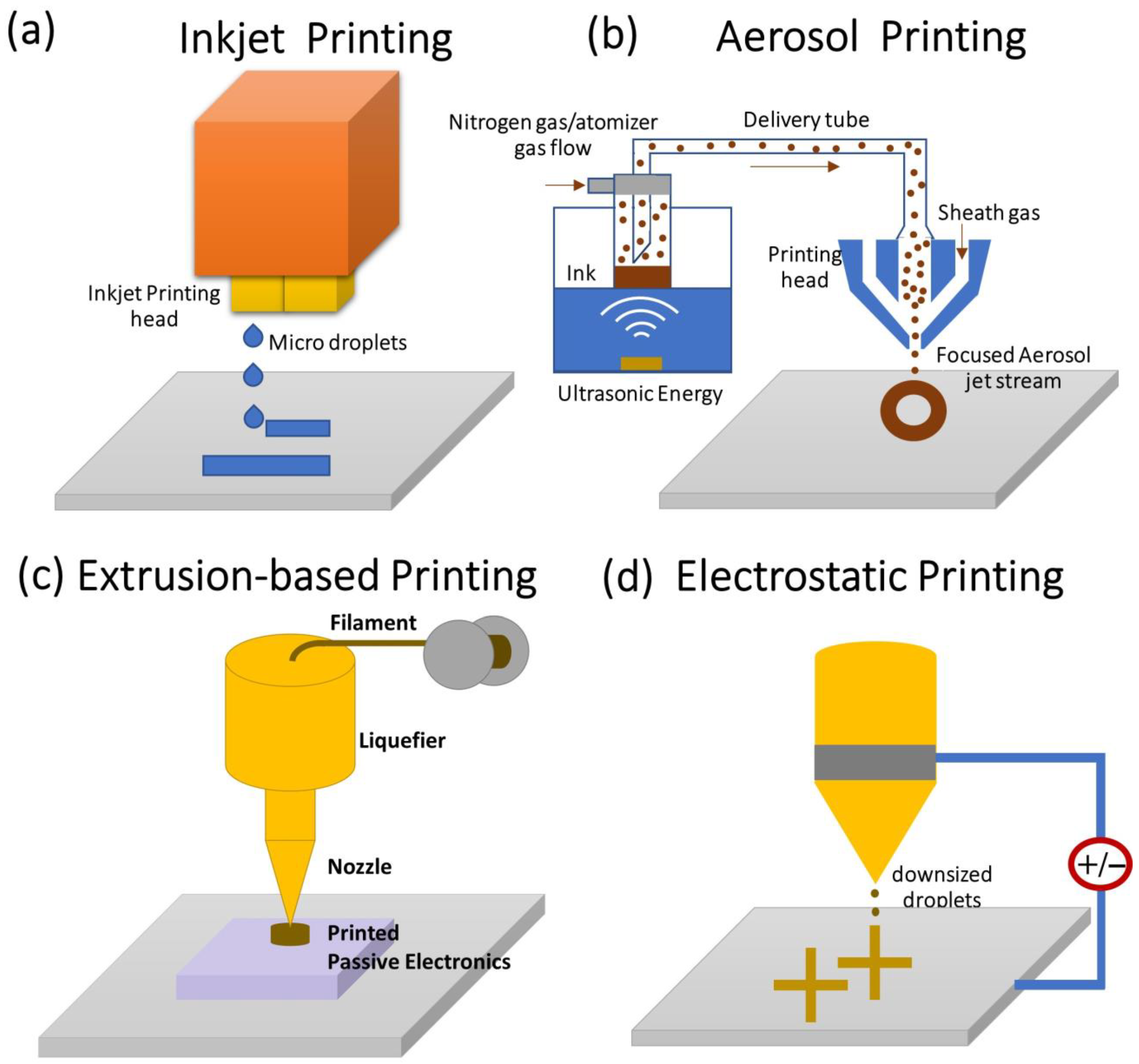
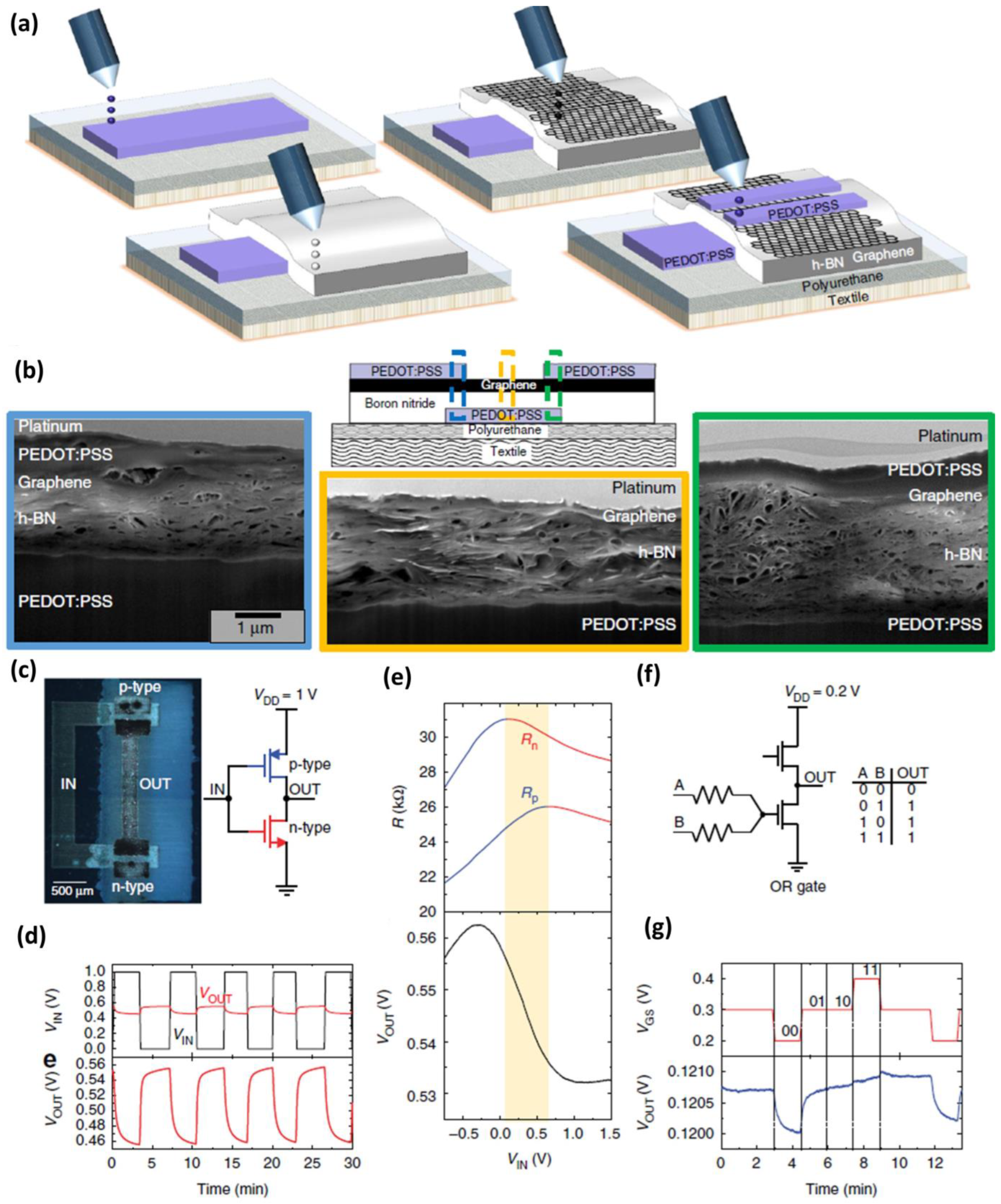
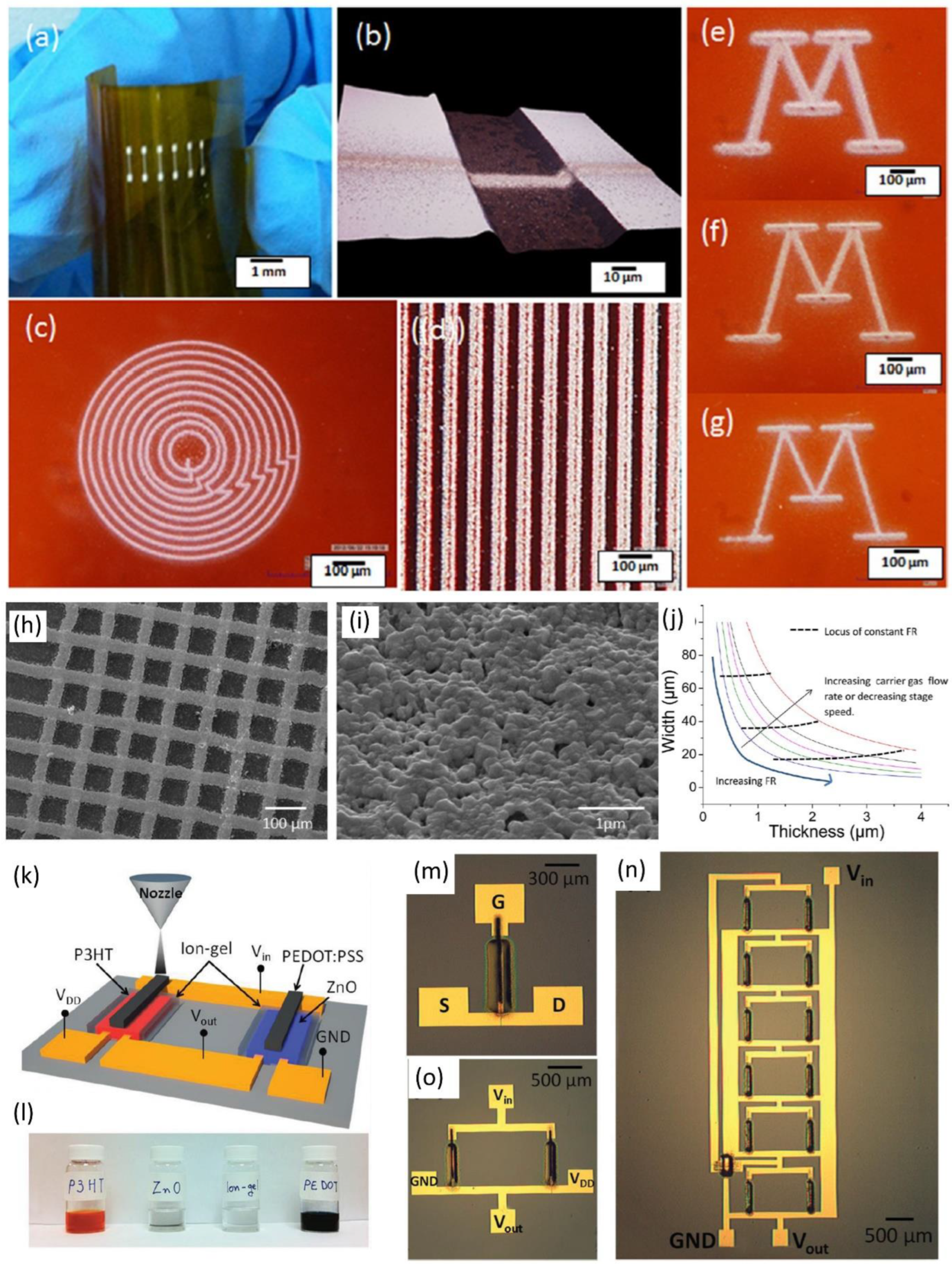
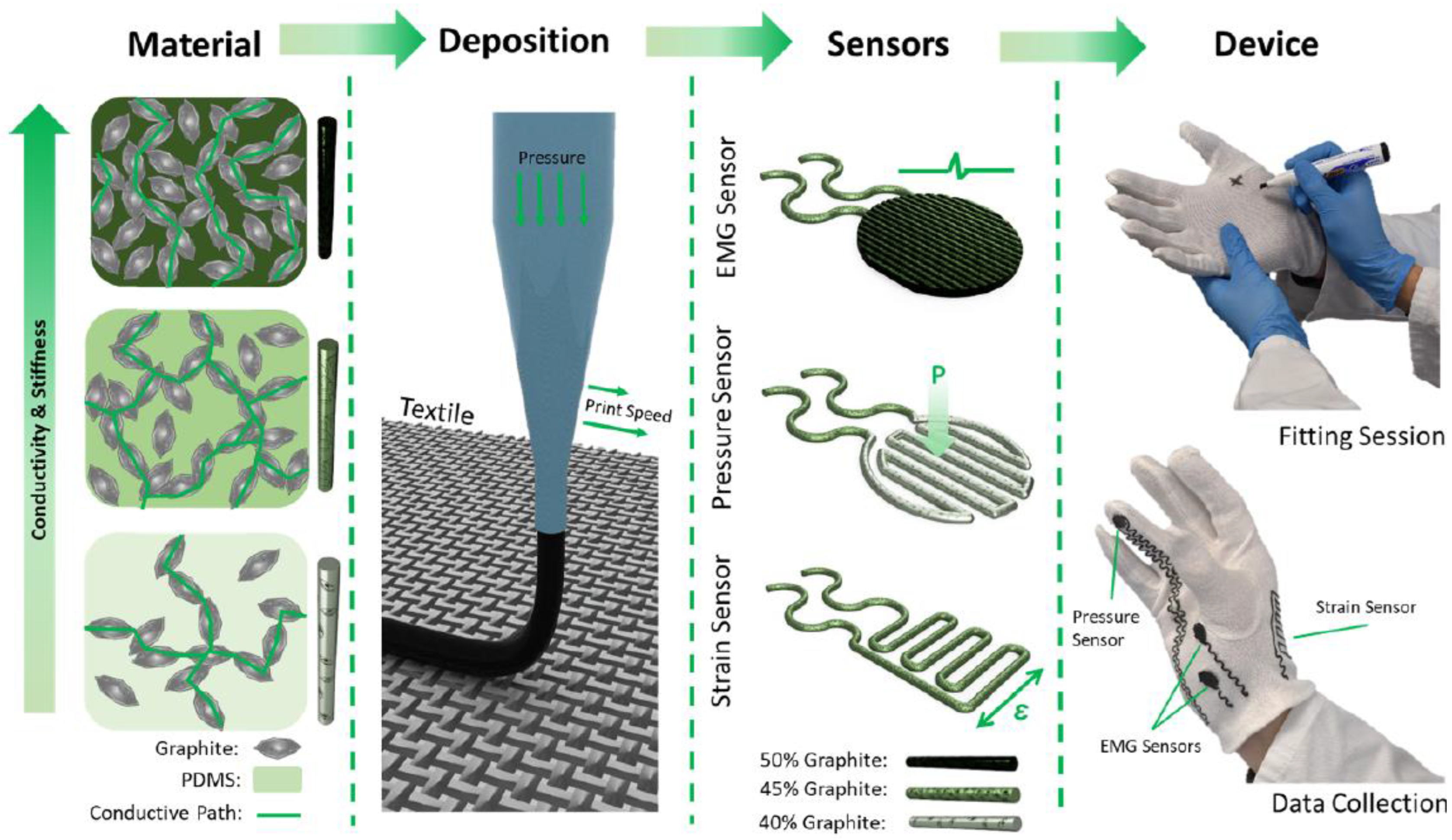
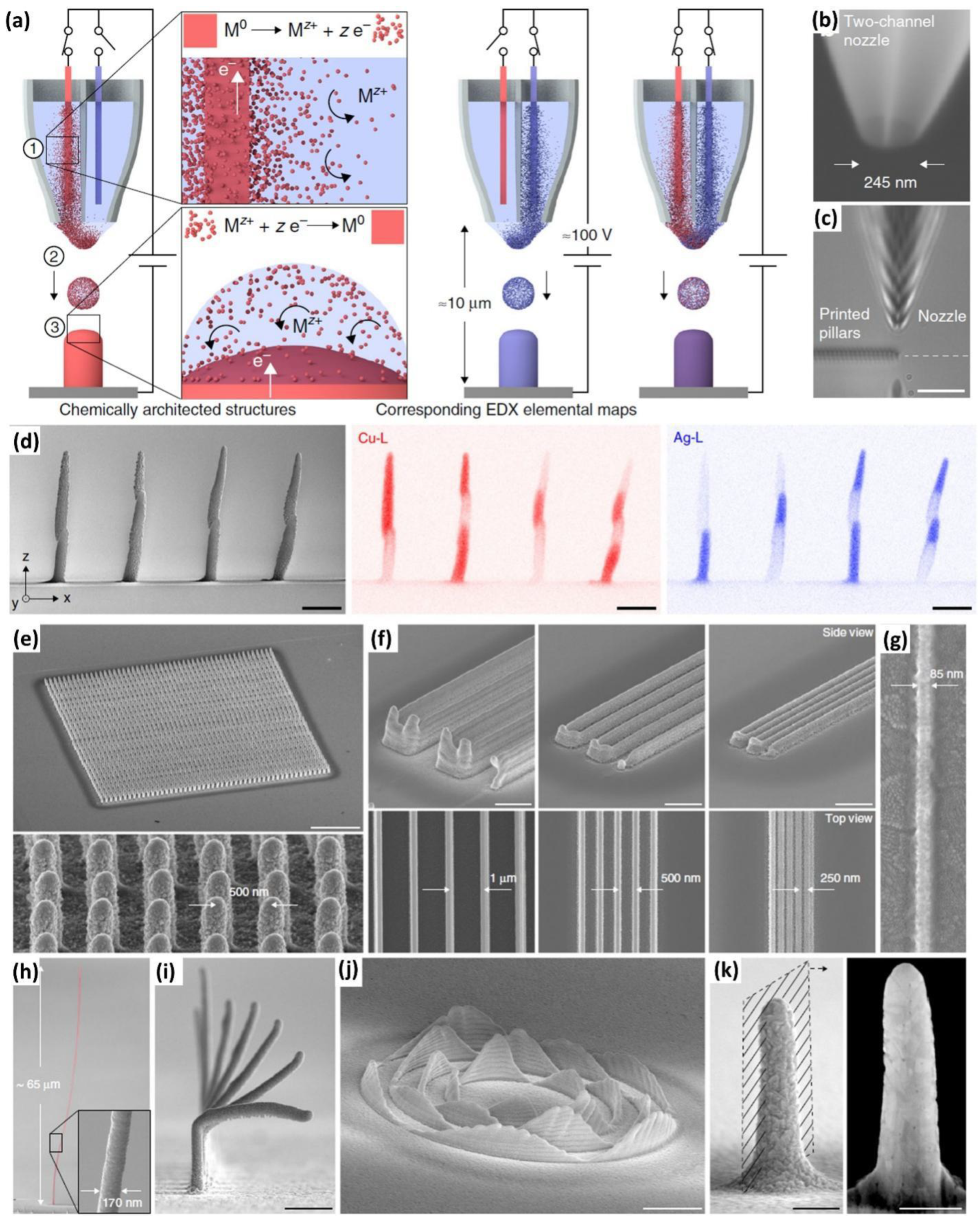
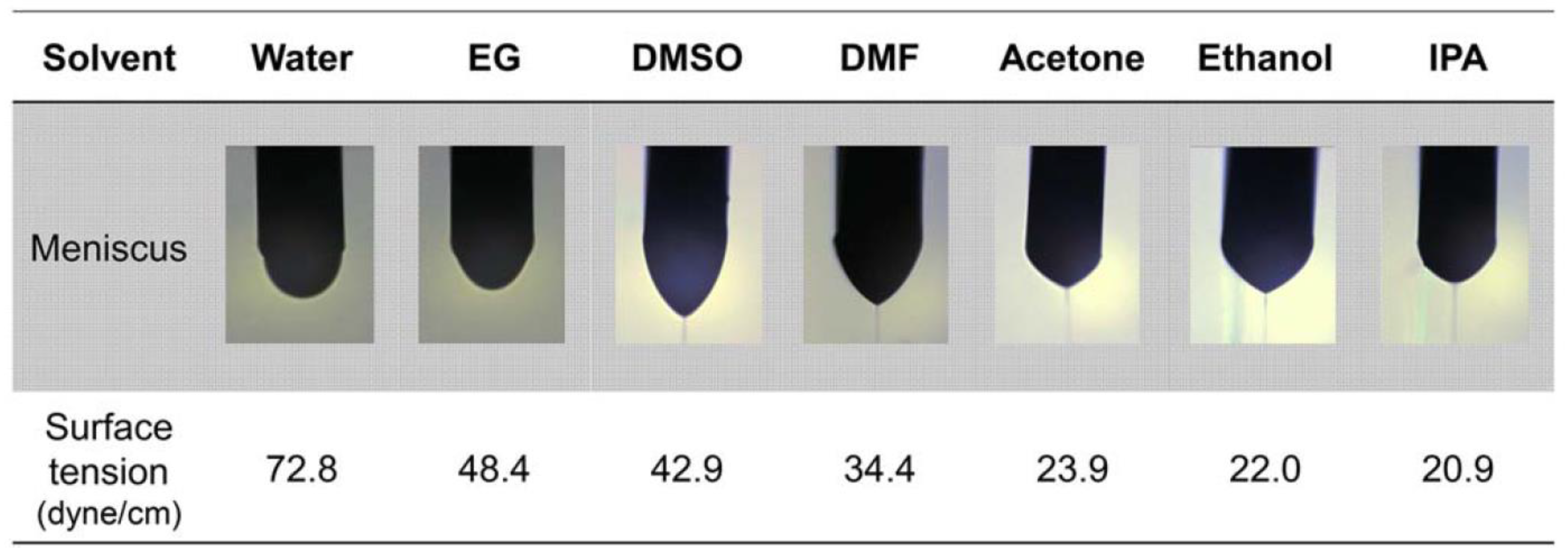

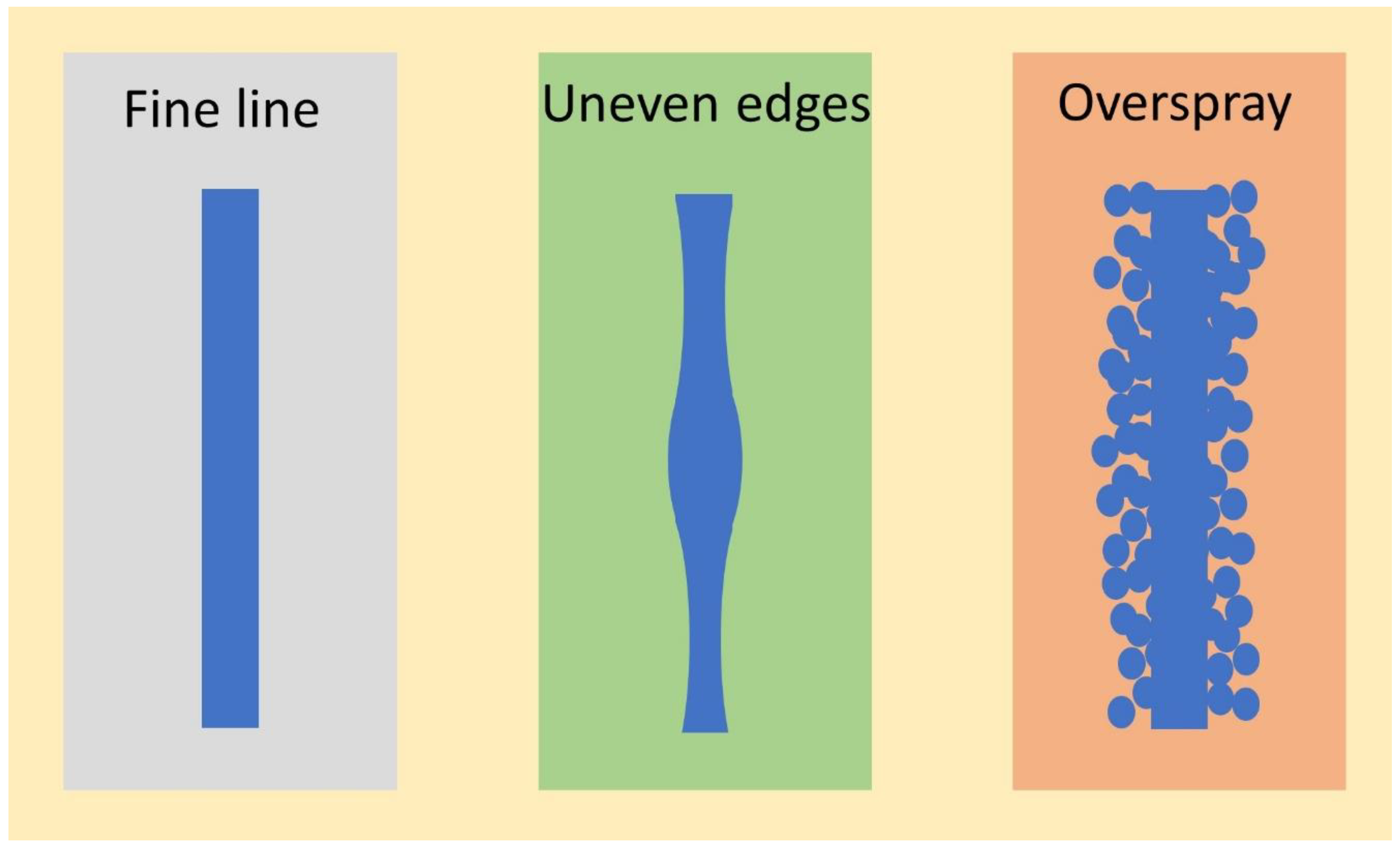
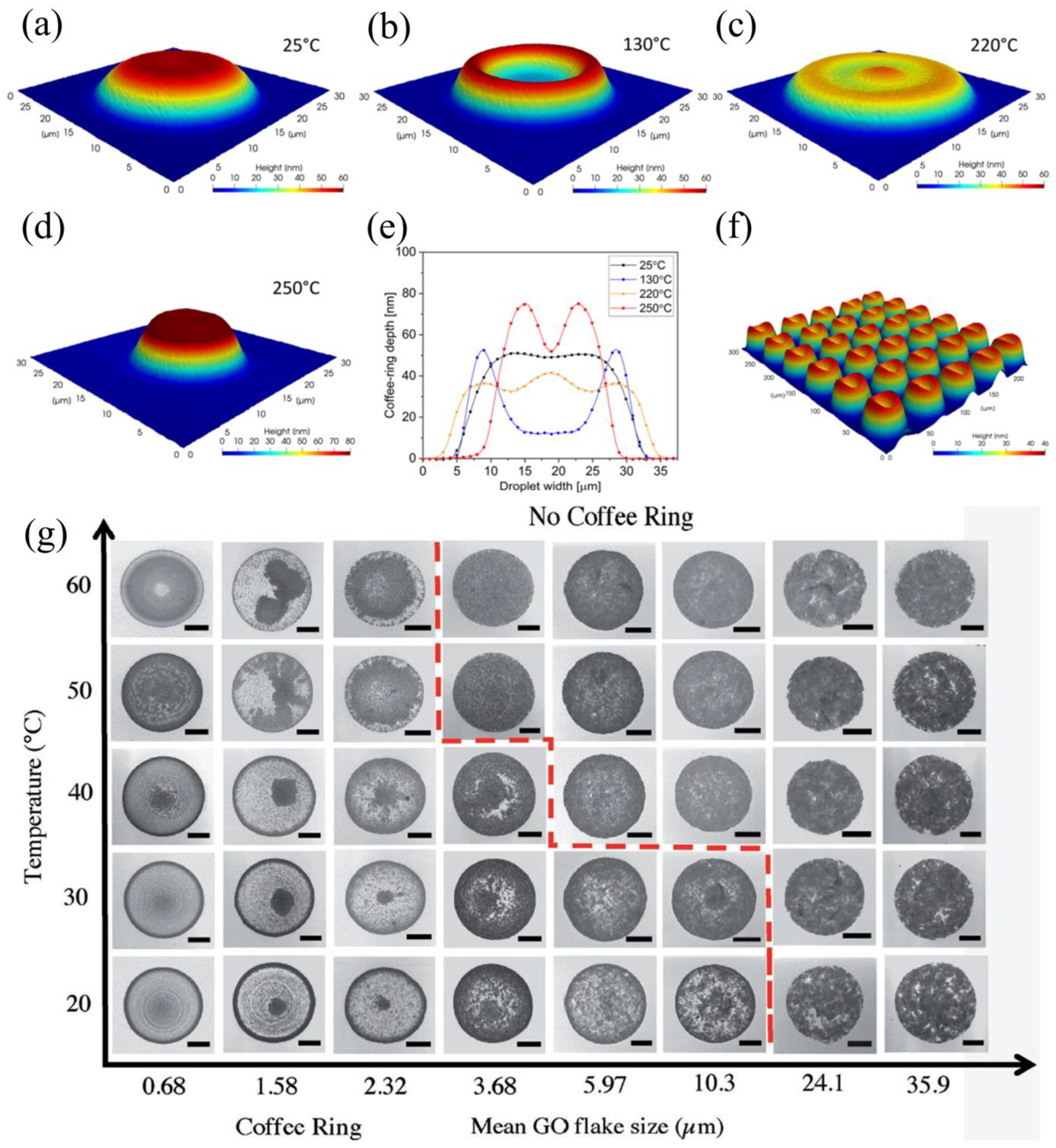
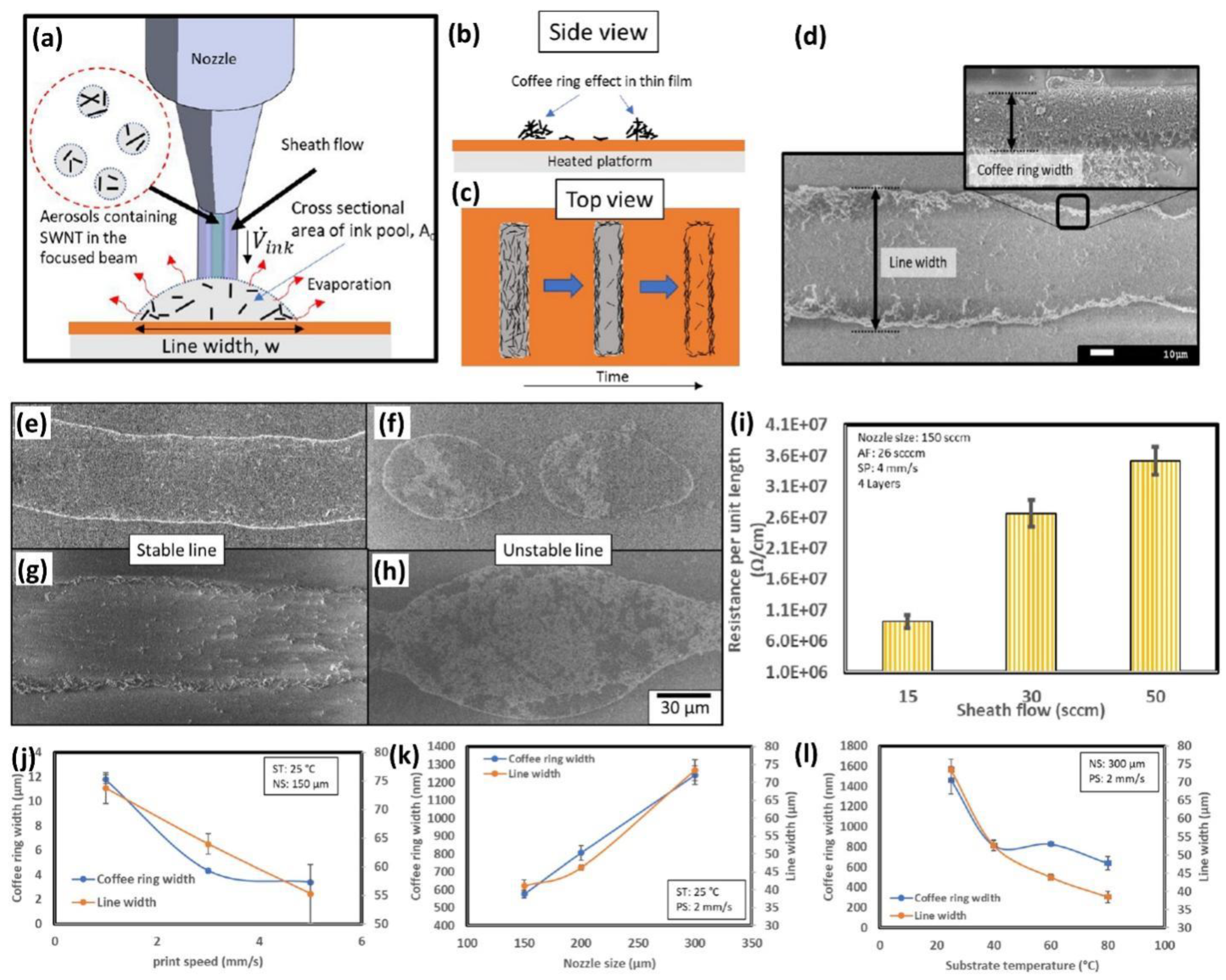
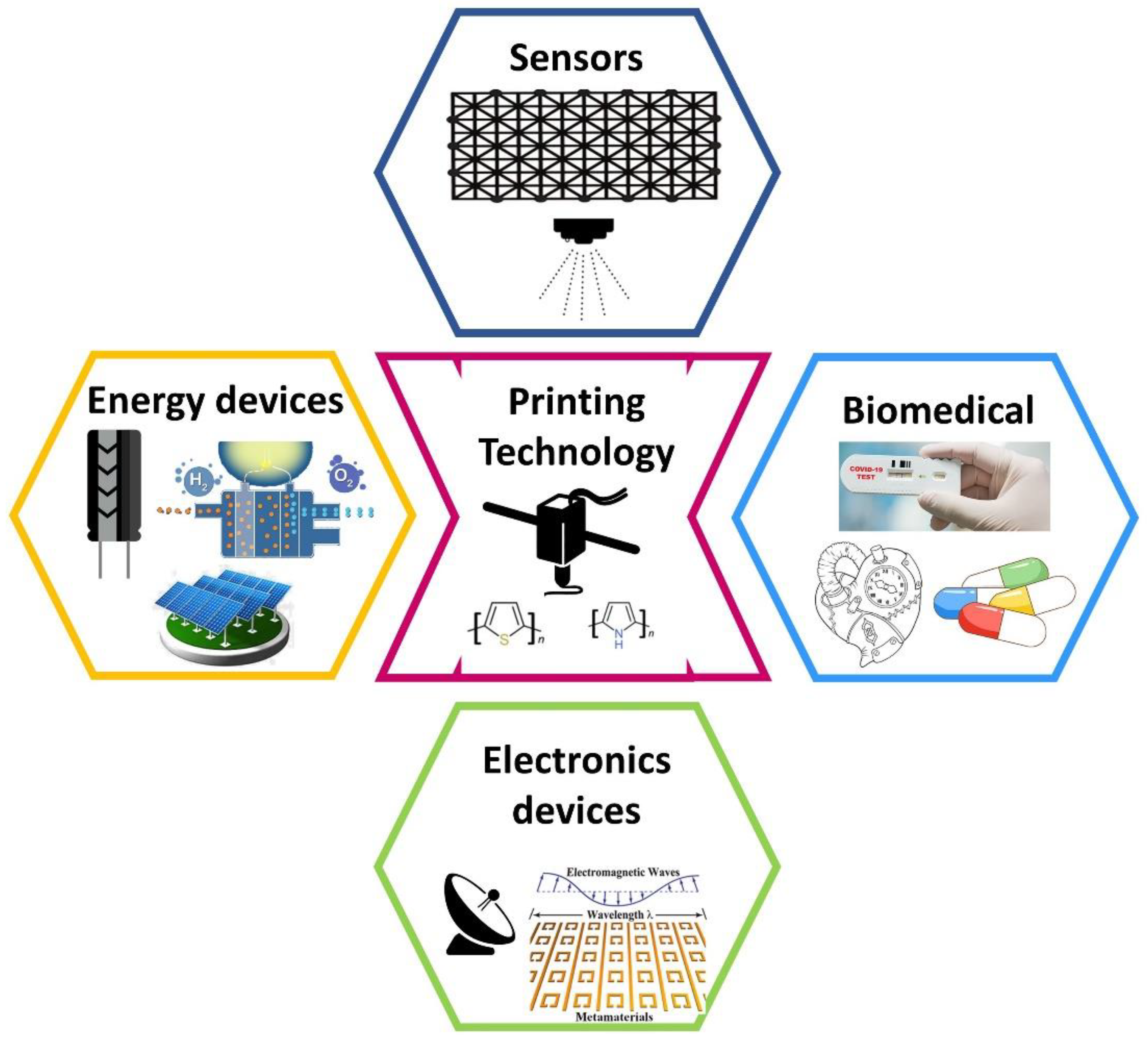
| Authors | Ink Materials | Properties | Technique | Nozzle Size |
|---|---|---|---|---|
| Tian Carey et al. [62] | h-BN, and graphene ink | Viscosity h-BN—1.7 mPa s, Viscosity graphene—1 mPa s, | Inkjet printing | 21 μm diameter nozzle |
| Samia Mekhmouken et al. [20] | Gold nanoparticle ink | Viscosity—2.75 mPa s Surface tension—34.2 mNm−1 | Inkjet printing | NA |
| Iara J. Fernandes et al. [21] | Silver nanoparticle ink | η—3.7 to 7.4 mPas Surface tension—33 to 36 mNm−1 | Inkjet printing | NA |
| Jin Sung Kang et al. [63] | Copper nanoparticle ink | Resistance—36.7 nΩ m | Inkjet printing | NA |
| Subimal Majee et al. [27] | Zinc nanoparticle ink | Surface tension—25 mNm−1 Viscosity—5 mPa s | Inkjet printing | 21 μm diameter nozzle |
| Guohua Hu et al. [12] | Black phosphorus ink | Surface tension—28 mNm−1 Viscosity—2.2 mPa s | Inkjet printing | 22 μm diameter nozzle |
| Kihyon Hong et al. [64] | Zinc oxide nanoparticle ink | Resistance—25 Ω cm | Aerosol Jet Printing | 250 µm diameter |
| Xuewei Feng et al. [65] | MoS2, and Ag nanoparticle ink | NA | Aerosol-Jet Printing | 300 µm diameter |
| Guo Liang Goh et al. [66] | Carbon nanotube ink | Resistance—600 kΩ/cm | Aerosol-Jet Printing | 150 µm diameter |
| Ankit Mahajan et al. [67] | Silver nanoparticle ink | Resistance—3.61 μΩ cm | Aerosol-Jet Printing | 100, 150, and 200 µm diameter |
| Li Tu et al. [68] | Silver nanowire ink | Sheet resistance—57.68 Ω/sq | Aerosol-Jet Printing | 200 µm diameter |
| Pavel V. Arsenov et al. [26] | Platinum ink | Surface tension—44 mNm−1 Viscosity 11 cP Resistivity—1.2 × 10−7 Ωm | Aerosol-Jet Printing | 300 µm diameter |
| Alain Reiser et al. [69] | Cu, and Ag | NA | Electrohydrodynamic printing | 245 nm diameter |
| Thi Thu Thuy Can et al. [70] | Cu | Viscosity 4000 cPs Resistivity—8 × 10−4 Ωm | Electrohydrodynamic printing | 100 µm diameter |
| Sangkyu Lee et al. [71] | IZO | NA | Electrohydrodynamic printing | 2 µm diameter |
Publisher’s Note: MDPI stays neutral with regard to jurisdictional claims in published maps and institutional affiliations. |
© 2022 by the authors. Licensee MDPI, Basel, Switzerland. This article is an open access article distributed under the terms and conditions of the Creative Commons Attribution (CC BY) license (https://creativecommons.org/licenses/by/4.0/).
Share and Cite
Chandrasekaran, S.; Jayakumar, A.; Velu, R. A Comprehensive Review on Printed Electronics: A Technology Drift towards a Sustainable Future. Nanomaterials 2022, 12, 4251. https://doi.org/10.3390/nano12234251
Chandrasekaran S, Jayakumar A, Velu R. A Comprehensive Review on Printed Electronics: A Technology Drift towards a Sustainable Future. Nanomaterials. 2022; 12(23):4251. https://doi.org/10.3390/nano12234251
Chicago/Turabian StyleChandrasekaran, Sridhar, Arunkumar Jayakumar, and Rajkumar Velu. 2022. "A Comprehensive Review on Printed Electronics: A Technology Drift towards a Sustainable Future" Nanomaterials 12, no. 23: 4251. https://doi.org/10.3390/nano12234251
APA StyleChandrasekaran, S., Jayakumar, A., & Velu, R. (2022). A Comprehensive Review on Printed Electronics: A Technology Drift towards a Sustainable Future. Nanomaterials, 12(23), 4251. https://doi.org/10.3390/nano12234251







